- Get Your Free Digital Marketing Audit Today! 🚀 Let's Boost Your Online Presence Together! 💡
- +1 (647) 995-1577
- info@flexforce.pro
Content Optimization in SEO: Key Strategies for Better Rankings
Content optimization in SEO refers to the process of making your content more relevant, engaging, and valuable to both users and search engines. It involves a combination of strategies and techniques aimed at improving the quality of your website content, ensuring it matches user intent, and making it easier for search engines to crawl and index. When done effectively, content optimization boosts organic search visibility and drives more traffic to your website.
Why Optimization Is More Than Just Keyword Insertion
While keyword insertion is still a vital aspect of SEO, content optimization goes beyond simply placing keywords into your content. It’s about creating a comprehensive and valuable user experience, ensuring that your content not only ranks well but also engages users, answers their questions, and guides them toward conversion. Optimization involves refining all aspects of the content—structure, readability, multimedia, and SEO elements—to deliver the best possible experience.
1. How Optimized Content Impacts Rankings, UX, and Conversions
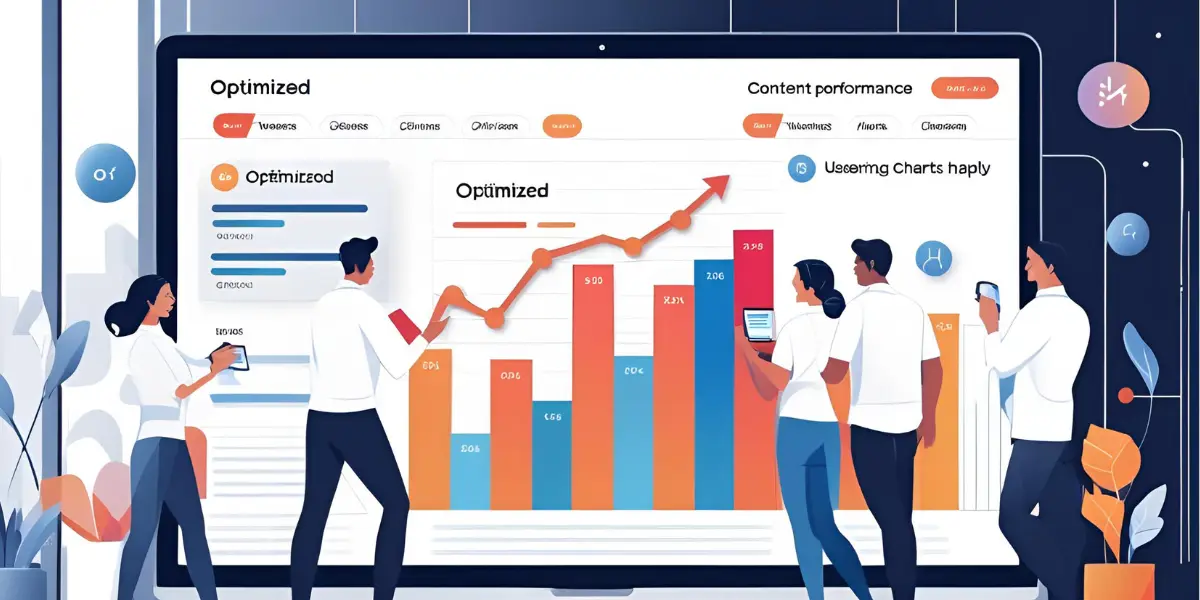
- Rankings: Optimized content signals to search engines that your page is relevant, informative, and valuable for specific queries, helping to improve rankings on SERPs.
- User Experience (UX): A user-friendly content structure, mobile responsiveness, and fast loading times are crucial for retaining visitors and improving engagement metrics like bounce rate, interaction and time on page.
- Conversions: Effective content optimization guides users through the conversion funnel with clear CTAs, relevant information, and an engaging user journey, ultimately leading to higher conversion rates.
2. The Goals of SEO Content Optimization
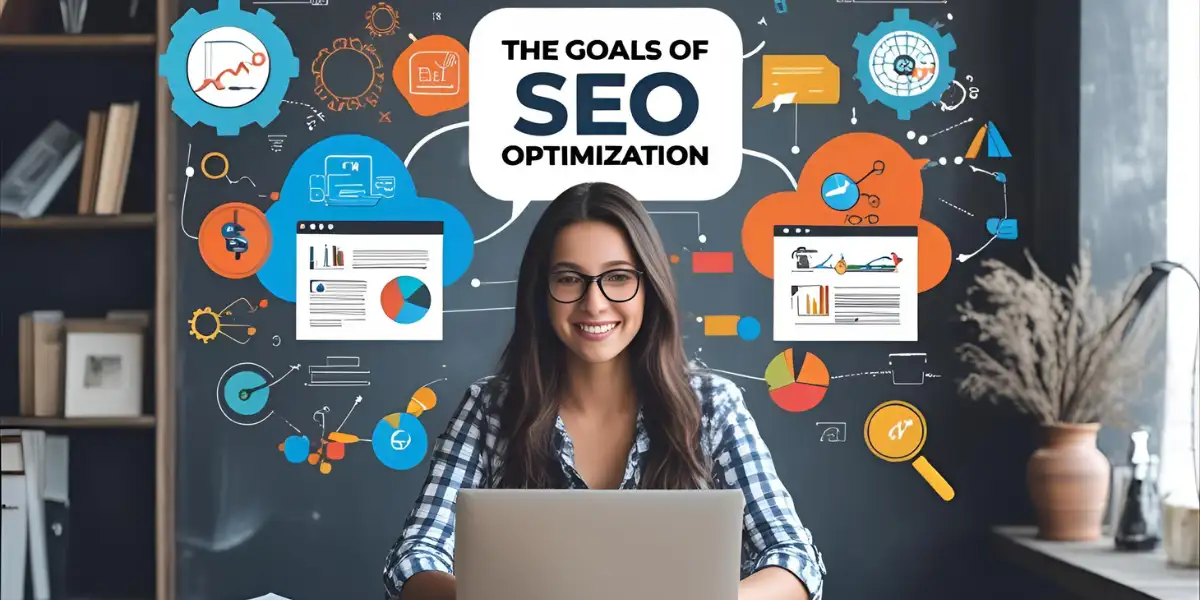
Content optimization is not just about making your content rank higher—it’s about improving multiple aspects of your digital marketing strategy. In this section, we’ll dive into the key goals of SEO content optimization, which will help you create content that resonates with your audience and performs well on search engines.
Increase Organic Visibility
One of the main goals of content optimization is to increase your website’s organic visibility. By optimizing your content for relevant keywords, you’re making it easier for search engines to find and rank your pages. Optimized content improves your chances of ranking on the first page of search results, making it more likely for users to find your website when they search for relevant topics. For businesses aiming to grow online through effective keyword targeting, consider exploring SEO services to help you reach more local and national customers.
Improve User Engagement
Engagement is a critical component of SEO success. Engaged users are more likely to stay on your site, interact with your content, and take desired actions such as sharing, commenting, or signing up for a newsletter. Optimized content with clear headings, subheadings, and multimedia elements (like videos or infographics) keeps users interested and encourages them to interact more with the page.
Enhance Content Relevance and Freshness
Keeping your content relevant and up to date is crucial for SEO. Search engines favor fresh, high-quality content that addresses current user needs and interests. Regularly updating and optimizing content ensures that it remains valuable to users and aligned with the latest trends or search intent.
Support the User’s Journey and Intent
SEO content optimization should focus on meeting the needs of users at every stage of their journey. Whether they are just starting to research a topic, comparing options, or ready to make a purchase, your content must address their specific questions and provide clear solutions. Aligning your content with the user’s search intent helps ensure that it’s relevant and useful, increasing the likelihood of conversions.
3. Core Elements of Optimized Content
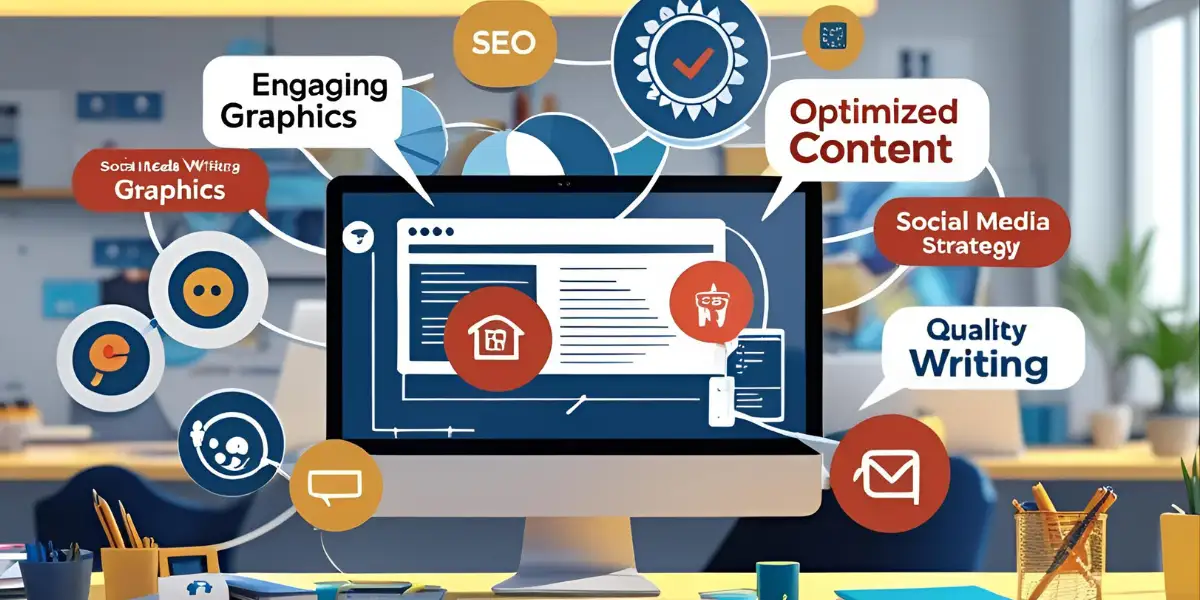
Creating content that performs well on search engines and engages users requires a strong foundation. This section will explore the core elements of optimized content, focusing on key factors that directly impact your content’s effectiveness.
Keyword Relevance and Semantic Clarity
Keywords remain a critical part of content optimization, but modern SEO requires a focus on semantic clarity—understanding the meaning behind the words users are searching for. Rather than just inserting keywords, it’s important to consider how related terms, phrases, and synonyms can support the main topic. Semantic SEO helps Google understand the context of your content and improves its relevance.
Clear Structure and Readability
Optimized content must be easy to read and navigate. Using clear headings (H1, H2, H3), short paragraphs, and bullet points ensures that your content is scannable and digestible. Search engines also prioritize well-structured content because it makes it easier for them to crawl and index your pages.
Engaging Visuals and Multimedia
Multimedia elements like images, videos, infographics, and diagrams help enhance the user experience by making content more engaging and informative. Visuals break up text-heavy content, increase time on page, and encourage social shares. They also provide additional SEO opportunities through image alt text, descriptions, and video captions.
On-Page SEO Elements (Title, Meta, H1, etc.)
On-page SEO elements such as the title tag, meta description, H1 tag, and URL structure are foundational to SEO content optimization. These elements help search engines understand what your content is about and make it more clickable in the search results. For best results, titles should include the target keyword, be compelling, and remain within recommended character limits.
Schema Markup
Adding schema markup (structured data) helps search engines interpret your content and qualify it for enhanced features like rich snippets. Common schemas for content include:
- Article
- BlogPosting
- FAQPage (especially for Q&A sections)
- VideoObject (for embedded videos)
💡 Use Google’s Rich Results Test to validate your schema.
“People Also Ask” Integration
Anticipate and address common related questions that users see in Google’s People Also Ask (PAA) boxes. Incorporating these Q&As into your content boosts topical authority and opens opportunities to rank for featured snippets.
Page Speed & Performance
Site speed is a ranking factor. Slow-loading pages increase bounce rates and hurt UX. Optimize your content’s performance by:
- Compressing images
- Using lazy loading
- Minimizing JavaScript and CSS
- Leveraging browser caching and CDNs
4. Step 1: Identify Optimization Opportunities
How do you know your content is optimized for SEO?
The first step is identifying whether your existing content is performing well — and where it might be falling short. Content optimization starts with a focused audit to uncover gaps, weaknesses, and opportunities for improvement.
Audit Existing Content Using Google Search Console, Ahrefs, and GA4
Start by reviewing your website’s content through various tools like Google Search Console, Ahrefs, and Google Analytics 4 (GA4). These tools provide insights into how your content is performing, highlighting pages that receive low organic traffic, have high bounce rates, or rank on lower pages of search results.
- Google Search Console: This tool shows which pages have indexing issues, low CTRs, or lack impressions for certain queries.
- Ahrefs: Use Ahrefs to identify backlink opportunities, keyword gaps, and pages that are ranking for long-tail queries.
- GA4: Track user engagement metrics such as time on page, bounce rate, and session duration to gauge how well users interact with your content.
Look for Declining Pages, Low CTRs, or Thin Content
Identify pages with declining traffic or low click-through rates (CTRs). These pages may require a content refresh, better keyword targeting, or improved on-page SEO elements. Pages with thin content (i.e., content that doesn’t provide enough value or information) are also prime candidates for optimization.
Check here our one client graph:
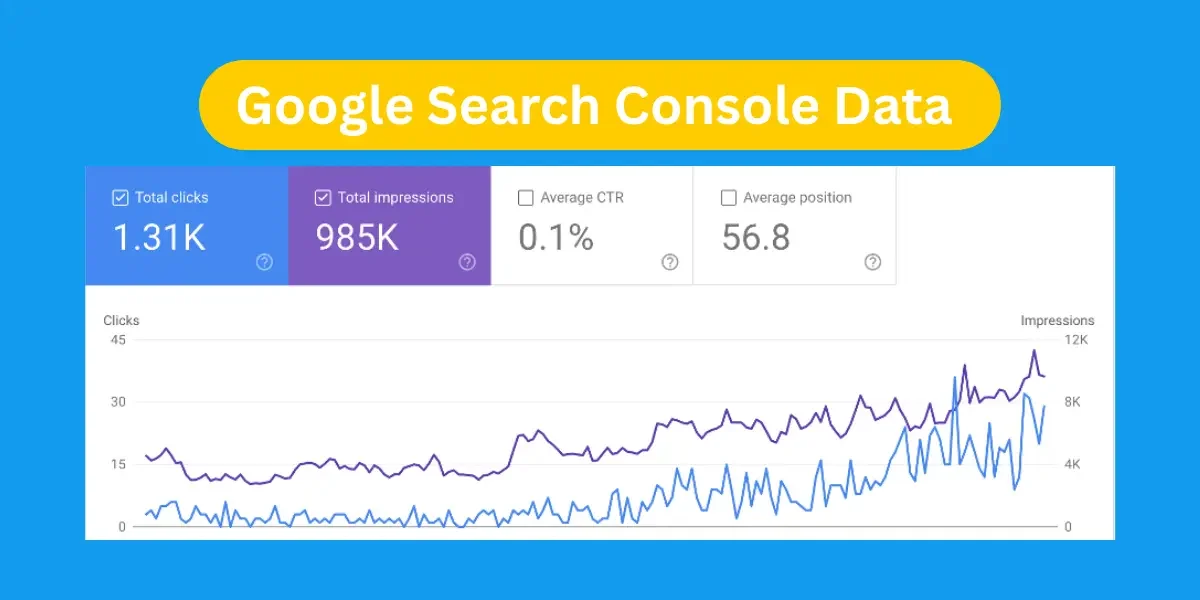
found that by revisiting low-traffic pages and enhancing them with in-depth content, he increased the organic reach by 35%.
Map Content to Keywords and Funnel Stages
Before diving into optimization, first prepare a spreadsheet that includes each content URL, page title, mapped funnel stage (awareness, consideration, or decision), and the user intent it addresses. This high-level view will help you organize and prioritize content based on strategic goals.
Understanding where each piece of content fits within the buyer’s journey ensures that you’re targeting the right keywords and serving the correct search intent:
- Top of Funnel (Awareness) – Broad, educational content targeting informational queries.
- Middle of Funnel (Consideration) – Solution-based content like comparisons or expert insights.
- Bottom of Funnel (Decision) – Conversion-focused content such as product pages, testimonials, and CTAs.
5. Step 2: Understand Search Intent Behind Each Keyword

Understanding search intent is crucial when optimizing content because it ensures your content meets the specific needs of users. Search intent is the reason behind a user’s query and can be categorized into four primary types: informational, commercial, navigational, and transactional. This section explains how to identify and align your content with the search intent behind each keyword.
Informational Intent
Users with informational intent are looking for answers, guidance, or knowledge on a particular topic. They are not yet ready to make a purchase but are gathering information. For this type of intent, your content should be educational and answer-oriented, often in the form of blog posts, guides, FAQs, or how-to articles.
Commercial Intent
Users with commercial intent are considering products or services and are looking for comparisons or reviews. They might not be ready to buy, but they are researching and narrowing down their options. Optimizing content for this intent involves creating comparison articles, product reviews, and content that explains the features, benefits, and value propositions of your offerings.
Navigational Intent
Users with navigational intent are looking for a specific website, page, or brand. These users have already made a decision on what they are looking for, and they want to navigate directly to a particular source. For this type of intent, your content should include brand names and specific product or service keywords.
Transactional Intent
Transactional intent users are ready to make a purchase or take immediate action, such as signing up for a service or downloading a product. Content optimized for transactional intent should include clear calls to action (CTAs), pricing information, and easy navigation to conversion points like product pages, landing pages, or checkout.
In your content optimization spreadsheet, add a column for Search Intent and note it for each URL. This will help you optimize content purposefully and avoid mismatches between keywords and user expectations.
In your optimization sheet, include the following columns:
URL | Title | Target Keyword | Funnel Stage | User Intent | Search Intent | Optimization Notes
This structure gives you a clear, actionable blueprint for aligning each piece of content with user expectations — which is exactly what search engines reward.
Analyze Current SERPs for Top Results and Content Types
Once you’ve identified the search intent, analyze the SERPs for the keyword you’re targeting. See which types of content are ranking well, such as blog posts, videos, product pages, or reviews. This will give you an idea of what Google deems most relevant for the keyword and help you align your content accordingly.
Use Private (Incognito) Mode for Clean Results
Always perform your searches in a private or incognito window to avoid personalized search results based on your history, location, or account activity. This ensures you’re seeing a neutral view of the SERP, closer to what an average user would see.
Use SEO Tools to Deepen Analysis
Supplement your manual review with tools like:
- Ahrefs or Semrush: Analyze top-ranking pages for backlink profile, keyword coverage, content word count, traffic estimates, and URL rating.
Add a “SERP Format” and “Top Competitor Pages” column to your content optimization spreadsheet.
6. Step 3: On-Page SEO Best Practices for Content Optimization

Optimizing on-page elements is crucial for ensuring that both search engines and users understand the value of your content. This step involves fine-tuning the essential elements of your page, such as titles, headings, and URLs, to align with SEO best practices and improve your chances of ranking higher.
SEO Title and Meta Description with CTR Triggers
The SEO title and meta description are two of the first things users see in search engine results. Craft compelling, concise titles and descriptions that include your primary keywords and CTR (click-through rate) triggers to encourage clicks. A well-written title can significantly impact whether a user clicks on your result or skips it.
- SEO Title: Should include the target keyword, be under 60 characters, and be descriptive yet attention-grabbing.
- Meta Description: Although not directly a ranking factor, the meta description influences CTR. Keep it under 160 characters and make sure it summarizes the page’s content effectively, while also including relevant keywords.
H1 to H6 Tags for Clear Topic Hierarchy
Heading tags (H1, H2, H3, etc.) help search engines understand the structure and hierarchy of your content. The H1 tag should be reserved for the main title of your page, while H2 and H3 tags should be used for subheadings that break down the content logically.
- H1: Should include the main keyword and represent the overall topic.
- H2-H6: These tags should organize the content in a way that makes it easier for both users and search engines to navigate. Use them to introduce sections and subsections.
Proper Use of Target and Secondary Keywords
When optimizing on-page content, ensure that your target keyword is placed naturally within the content, especially in the first 100 words, as well as in headings and throughout the body. Don’t forget to incorporate secondary keywords and LSI (Latent Semantic Indexing) keywords, which help reinforce the topic’s relevance and broaden your content’s keyword reach.
SEO-Friendly URL Structure
Your URL should be simple, readable, and include the target keyword. An optimized URL structure helps search engines crawl your page more easily and gives users an idea of what to expect from the content.
An effective target keyword rich URL is readable, easy to understand and simple. Optimized URL structure not only aids users know what to expect, it also helps search engines crawl the page easily. For instance, it is easier to implement SEO strategies when the URLs are concise and descriptive, especially for eCommerce businesses.
When developing keyword focused campaigns, for example, jewelry SEO strategies, having keyword rich descriptive URLs aids boost organic visibility and click through rates.
Furthermore, the application of structured data, such as local business schema markup enhances the way URLs are displayed in search results, improving local relevance and other intent driven queries.
7. Step 4: Improve Content Structure and Readability

A well-structured piece of content not only helps search engines understand the value of your content but also ensures that users can easily read, understand, and engage with your page. This step focuses on how to improve the structure and readability of your content to create a better user experience and enhance your SEO performance.
Use Short Paragraphs, Headings, and Bullet Points
Long blocks of text can be overwhelming for users, causing them to bounce off your page. Break your content into short paragraphs that are easy to read and digest. Use headings (H2, H3) to organize the content into logical sections, and incorporate bullet points to highlight key points. This structure improves content scannability, making it more user-friendly.
Ensure Logical Flow and Content Scannability
Content should flow logically from one section to the next. Ensure that there is a natural progression in the information you provide. Additionally, make your content scannable by using short paragraphs, bolded text, and clear transitions. Users should be able to easily skim your page and find the key insights they’re looking for.
Tools for Readability: Hemingway, Grammarly, Surfer SEO
There are several tools available to help improve the readability of your content. Tools like Hemingway and Grammarly can help you simplify complex sentences, correct grammar mistakes, and ensure that your content is clear and easy to understand. Surfer SEO also provides readability insights and suggests improvements to make your content more digestible for users.
8. Step 5: Add or Improve Visual Elements

Visual elements such as images, infographics, videos, and diagrams can significantly enhance the user experience and contribute to better content performance in SEO. In this step, we’ll explore how to incorporate visuals effectively, improve engagement, and boost your content’s SEO.
Use Images, Infographics, and Videos for Engagement
Visual elements break up text-heavy content and make it more engaging. Incorporating images, infographics, and videos into your content helps to illustrate complex ideas, tell a compelling story, and maintain user interest. Visuals also increase the likelihood that your content will be shared on social media, which can help drive more traffic.
Add Alt Text and Descriptive Filenames for SEO
Search engines cannot “see” images the way humans can, so it’s important to add alt text and descriptive filenames for each image. Alt text helps search engines understand what the image is about and also improves accessibility for users with visual impairments. Using descriptive, keyword-rich alt text can provide an additional SEO boost.
Embed Visual Aids That Support the Topic
When selecting visuals, ensure they are relevant to the content and help explain or enhance the topic. Infographics are particularly valuable for summarizing key points, while videos can demonstrate how a product works or explain a process. Visual aids should support the content, not distract from it, ensuring that they add value to the user’s experience.
9. Step 6: Optimize for Semantic SEO
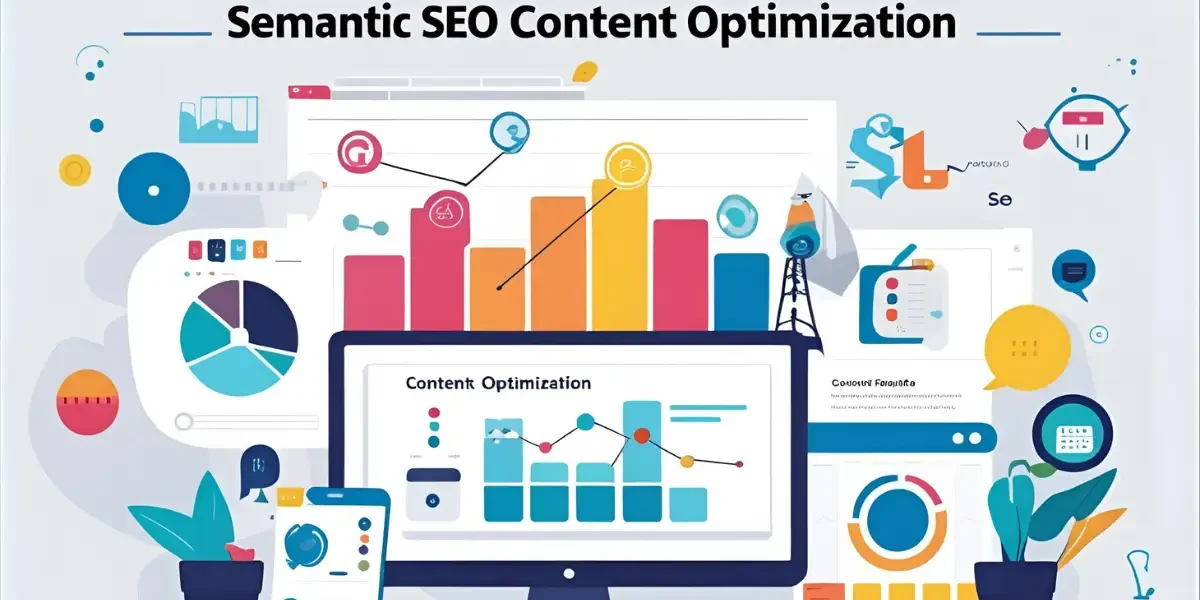
Semantic SEO focuses on improving content’s relevance by understanding the context behind the keywords and using related terms that search engines can recognize. This step involves using synonyms, related terms, and leveraging natural language processing (NLP) to help search engines better understand and rank your content.
Use Synonyms, Related Terms, and LSI Keywords
Incorporating synonyms and related terms (such as LSI – Latent Semantic Indexing keywords) in your content helps search engines understand the broader context of your topic. Instead of repeating the same keyword multiple times, try to use variations that still align with the main topic. This prevents keyword stuffing and allows your content to rank for a wider range of relevant terms.
Cover Related Questions and Subtopics
Addressing related questions and covering subtopics that are relevant to the main keyword increases the semantic relevance of your content. For example, if you’re writing about “how to improve SEO,” you can include subtopics like technical SEO, on-page SEO, and content marketing. By doing so, your content will appear more comprehensive and will be more likely to satisfy both user intent and search engine algorithms.
Leverage Google’s NLP Expectations (via tools like Clearscope, Frase)
Google’s NLP (Natural Language Processing) technology understands content at a deeper level. Tools like Clearscope and Frase can help you optimize content by analyzing top-ranking pages and suggesting relevant terms, phrases, and content gaps. These tools help you ensure that your content aligns with Google’s expectations of what constitutes high-quality, relevant content.
10. Step 7: Enhance Internal and External Linking
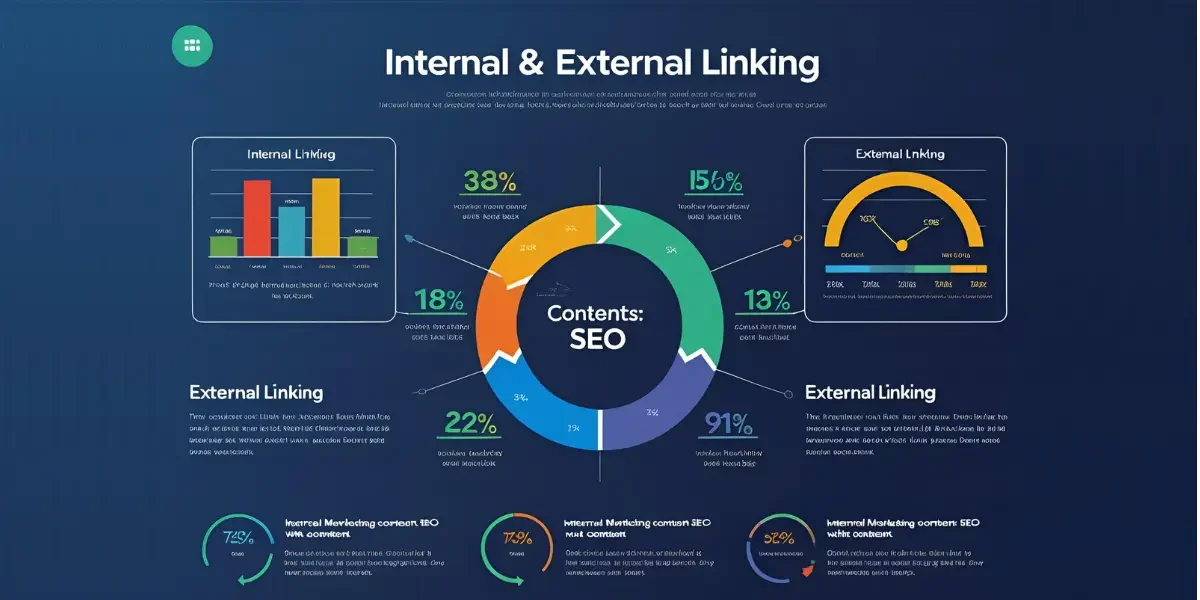
Effective linking is a key component of SEO optimization. Internal and external links help search engines understand the structure of your content and the relationships between different pieces of information. In this step, we’ll discuss how to optimize your internal and external linking strategy to improve SEO and user experience.
Link to High-Authority Pages Within and Outside Your Site
Internal linking connects different pages within your website. Linking to high-authority pages on your site helps search engines understand the most important content on your site, improving the overall SEO value of those pages. Additionally, it creates a seamless user experience by providing additional resources that users may find valuable.
External linking is also important. Linking to reputable, authoritative sources outside your website enhances the credibility of your content. Search engines view links to high-authority sites as a sign of quality, which can positively affect your SEO rankings.
Anchor Text Optimization for Contextual Flow
When using internal or external links, anchor text plays a vital role in SEO. The anchor text should be descriptive and relevant to the linked content. Avoid using generic phrases like “click here” or “read more.” Instead, use relevant keywords or phrases that provide context to both users and search engines. This helps improve the relevance of the linked content and boosts SEO.
Identify Orphan Pages and Create Link Bridges
Orphan pages are pages on your site that don’t have any internal links pointing to them. These pages are harder for search engines to discover and may not get the attention they deserve. Identify orphan pages through tools like Screaming Frog or Google Search Console and create internal links that connect these pages to other relevant content. This ensures that every page on your site has the opportunity to contribute to your overall SEO efforts.
11. Step 8: Address Technical Content Factors

While content quality is vital, technical aspects of your content also play a significant role in SEO optimization. In this step, we’ll focus on technical factors that affect how search engines crawl, index, and rank your content. Ensuring that your content is technically sound can improve visibility and provide a better user experience.
Ensure Fast Loading Times and Mobile Responsiveness
Website speed and mobile-friendliness are crucial ranking factors for Google. Users expect pages to load quickly, and if your page takes too long, they may leave before it even loads. Moreover, with more users browsing on mobile devices, your content must be optimized for mobile responsiveness. Pages that load quickly and provide a smooth mobile experience are more likely to rank higher and keep users engaged.
Use Schema Markup for Rich Results
Schema markup is a type of structured data that helps search engines understand the content on your page more precisely. By using schema markup, you can provide additional information about your content, such as ratings, events, product details, and more. This can lead to rich snippets—enhanced search results that include extra information like star ratings, images, and other details that stand out in the SERPs.
Minimize Broken Links and Redirect Chains
Broken links (404 errors) and redirect chains can harm your SEO efforts. Search engines struggle to crawl pages that have broken links, and redirect chains (multiple redirects) can confuse search engines and delay page loading times. Regularly audit your site to identify and fix broken links and avoid excessive redirects to ensure a smoother user experience and better crawling efficiency.
12. Step 9: Add CTAs and Conversion Elements
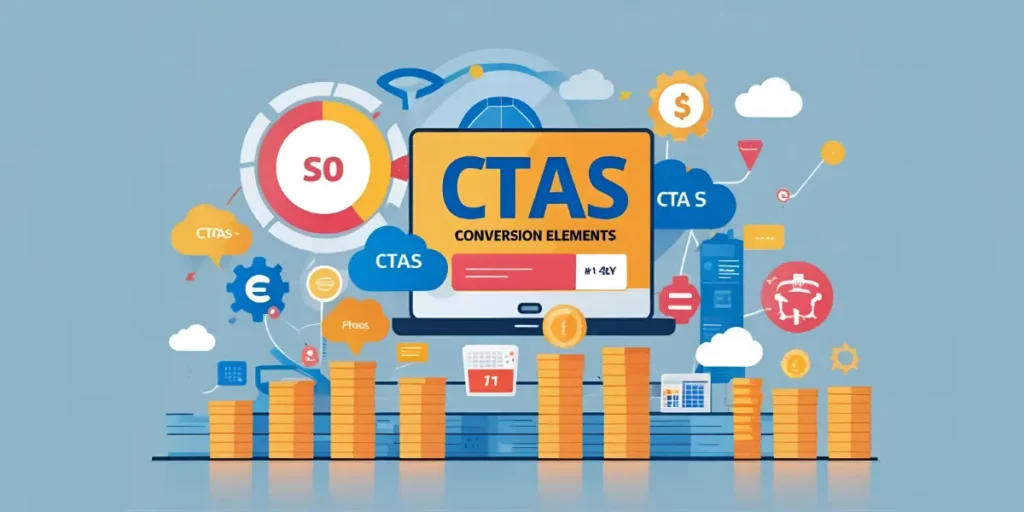
Once your content is optimized for SEO and readability, the next step is to focus on guiding your visitors toward action. Calls to Action (CTAs) and conversion elements are critical for turning visitors into leads, subscribers, or customers. In this section, we will discuss how to strategically place CTAs and other conversion elements to drive engagement and improve ROI.
Include Clear, Contextual Calls-to-Action
A call-to-action (CTA) is a prompt that encourages your users to take a specific action, such as subscribing to your newsletter, downloading an e-book, or making a purchase. Your CTAs should be clear, concise, and relevant to the content on the page. Placing your CTAs within the context of the content helps increase the likelihood that users will take the desired action.
Guide Users to Next Steps: Related Posts, Downloads, or Contact Pages
Your content shouldn’t be a dead end. Once a user finishes reading a blog post, the next step should be clear and valuable.
Encourage users to continue engaging with your brand by guiding them to:
- Related blog posts to deepen their knowledge
- Downloadable resources like eBooks, checklists, or templates
- Contact pages for questions, consultations, or service inquiries
- Newsletter or email subscription forms to stay updated with future content, offers, or insights
✅ Tip: Place your subscribe form at logical points — such as the end of the post or in the sidebar — with a compelling value proposition (e.g., “Get the latest SEO tips straight to your inbox”).
These follow-up actions not only improve user experience and retention, but also increase the likelihood of conversions, lead generation, and repeat visits.
Optimize Forms and Buttons for UX
Your forms and buttons play a key role in user interaction and conversion. They should be easy to find, intuitive to use, and visually prominent across all devices — especially mobile.
Use clear, action-oriented call-to-action (CTA) buttons, such as:
- “Start Your Free Trial”
- “Download Now”
- “Get Instant Access”
Keep forms short and focused, asking only for essential information to reduce friction.
Make sure all CTAs are visually distinct, mobile-friendly, and placed in high-visibility locations (e.g., top fold, end of post, exit-intent popups).
In emergency-driven or time-sensitive contexts (e.g., limited offers, urgent support requests), your CTAs should reflect urgency — like “Get Help Now” or “Claim This Offer Today.”
✅ Tip: Test different CTA styles and button placements to optimize user interaction and increase conversions over time.
By fine-tuning the usability and messaging of your forms and buttons, you enhance user experience, encourage meaningful engagement, and drive more goal-oriented actions on your site.
13. Step 10: Keep Content Updated and Evergreen

SEO is not a one-time task; it’s an ongoing process. As time passes, content can become outdated, and rankings can drop if your page isn’t refreshed regularly. In this step, we’ll discuss how to maintain content relevance and keep it updated for both users and search engines.
Refresh Stats, Screenshots, and Outdated Info
One of the most important aspects of keeping content up-to-date is refreshing any outdated information. This includes statistics, research, case studies, screenshots, or any time-sensitive data. Google rewards pages that provide accurate, up-to-date information, so revisiting and updating your content periodically is essential for maintaining your rankings.
Add New Insights, FAQs, or Case Studies
When updating your content, consider adding new insights, user feedback, FAQs, or relevant case studies. This enriches the content, making it even more valuable to users. Additionally, adding fresh content signals to Google that your page is actively maintained and relevant, which can improve your rankings over time.
Update Publishing Dates and Notify Search Engines
When you make significant updates to a piece of content, update the publishing date to reflect the most recent revision. This not only lets users know the content is fresh but also signals to search engines that the page has been updated. You can also notify Google through Google Search Console by submitting your updated URL for re-crawling.
Track Update Frequency by Content Type
To manage this process more efficiently, define a column in your content optimization sheet for:
- Content Type (e.g., blog post, landing page, case study, product page)
- Recommended Update Frequency — based on how fast the content becomes outdated:
- Weekly (e.g., trending posts, tool roundups)
- Monthly (e.g., stats-based blog posts, seasonal content)
- Quarterly (e.g., evergreen guides, pillar content)
✅ Example: A “2025 SEO Trends” post may need monthly updates, while a beginner’s guide to keyword research might only need quarterly reviews.
This system keeps your team aligned and helps prioritize updates that drive the biggest SEO impact.
14. Content Optimization Tools You Should Use
Optimizing content manually can be time-consuming, but with the right tools, you can streamline your efforts and get better results. In this section, we’ll explore some essential content optimization tools that can help you improve your SEO, readability, and overall content performance.
On-Page SEO: Yoast, Rank Math, All-in-One SEO
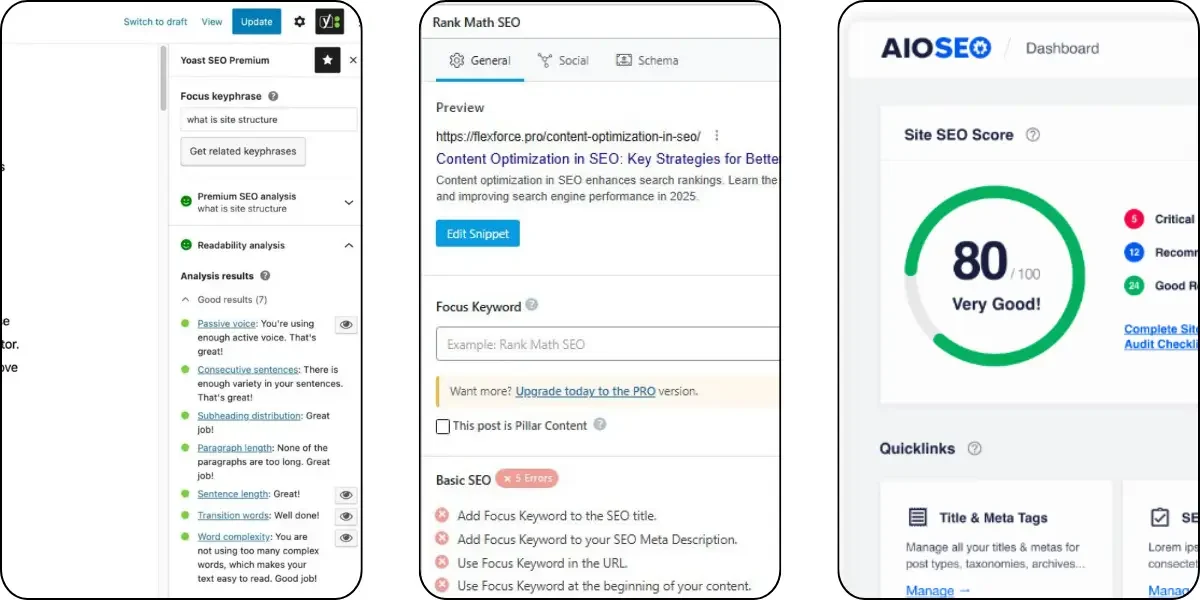
On-page SEO plugins like Yoast, Rank Math, and All-in-One SEO help optimize title tags, meta descriptions, headers, and more. These tools guide you through best practices for on-page SEO and provide feedback on your content’s SEO score. They also offer suggestions for keyword usage, readability, and content structure.
Content Analysis: Surfer SEO, MarketMuse, NeuronWriter
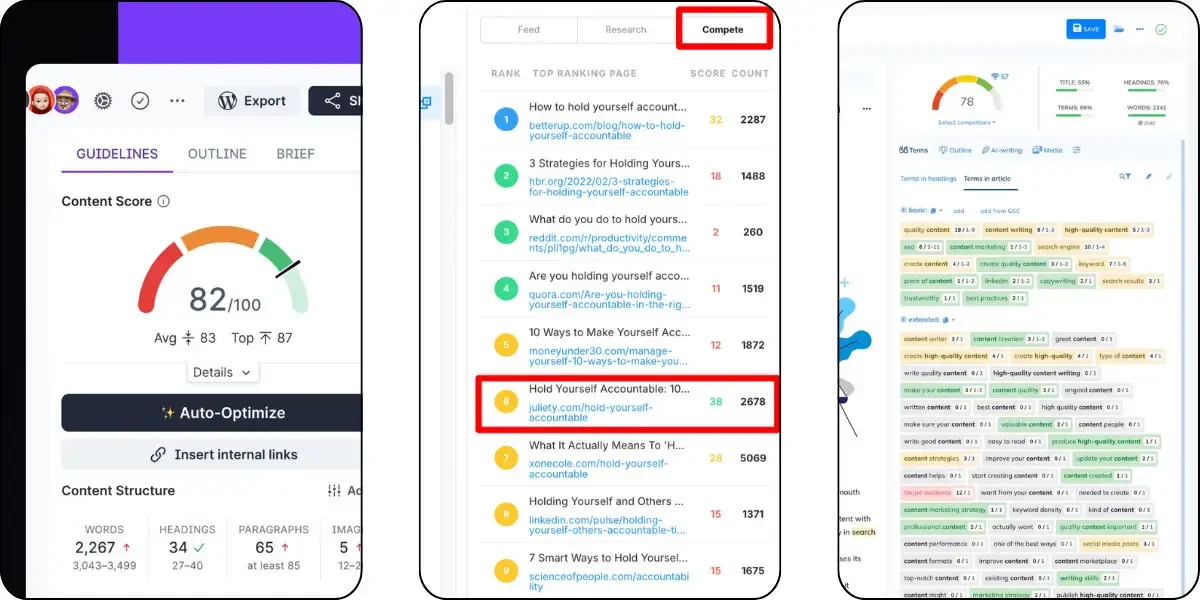
Surfer SEO, MarketMuse, and NeuronWriter are content analysis tools that help optimize content for better rankings. These tools analyze top-ranking pages, suggest relevant keywords, and provide a content score based on factors like keyword density, readability, and semantic relevance. They also help you create content that aligns with search intent, boosting your chances of ranking higher in search results.
Technical Support: Screaming Frog, Sitebulb, PageSpeed Insights
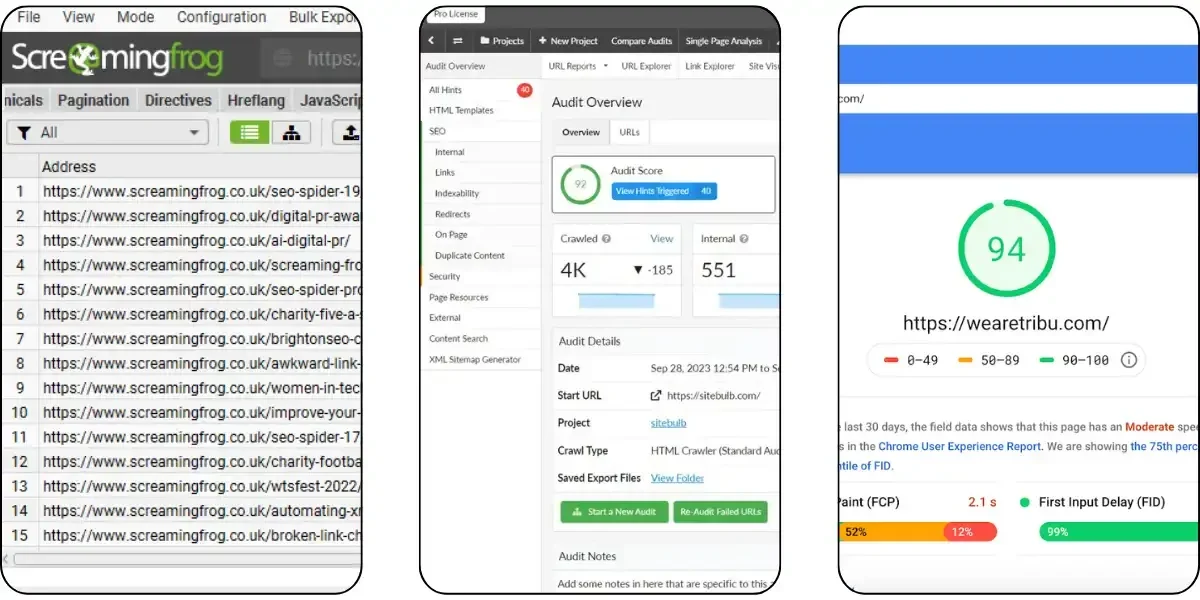
For a more technical approach to SEO, tools like Screaming Frog, Sitebulb, and PageSpeed Insights can help you audit your website and identify issues related to broken links, site structure, and page speed. These tools help ensure that your site is optimized for search engines and provides a seamless user experience.
15. Optimizing for Featured Snippets and SERP Features
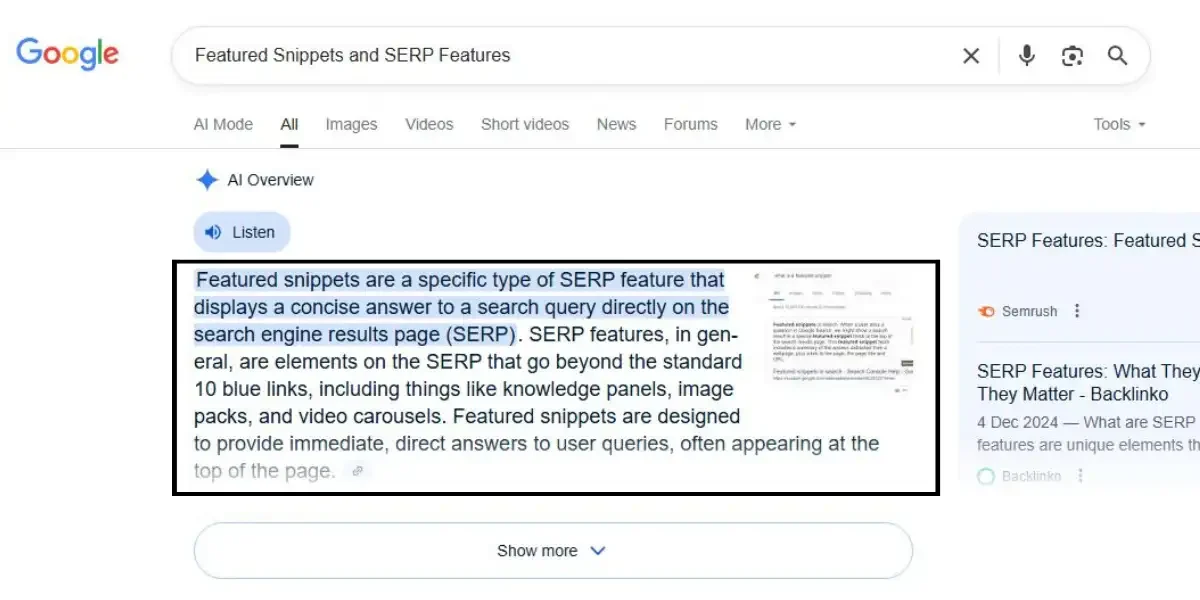
Featured snippets and other SERP (Search Engine Results Page) features have become an essential part of SEO strategy. These elements allow your content to stand out and potentially drive more organic traffic. In this section, we’ll explore how to optimize your content for featured snippets and other SERP features to improve visibility and engagement.
Structure Lists, Tables, and Definitions Clearly
Google often pulls content from websites to feature in rich snippets, including lists, tables, and definitions. If your content is structured clearly, it increases the likelihood of being featured. Use bullet points, numbered lists, and concise definitions to make your content easier for search engines to pull.
Use FAQ Sections and How-To Schema
Another great way to optimize for featured snippets is by using FAQ sections and How-To schema. Google often displays content from FAQ sections directly in the SERPs, as well as step-by-step guides from how-to schema. These elements are highly engaging and can increase your chances of being featured in snippets.
Aim for Position Zero with Precise, Value-Rich Content
Position zero is the coveted spot that appears above traditional search results in a featured snippet box. To achieve this position, your content must provide clear, concise, and highly valuable information in response to user queries. Ensure that your content directly answers the most common search questions in a way that aligns with Google’s featured snippet guidelines.
16. Measuring Optimization Success
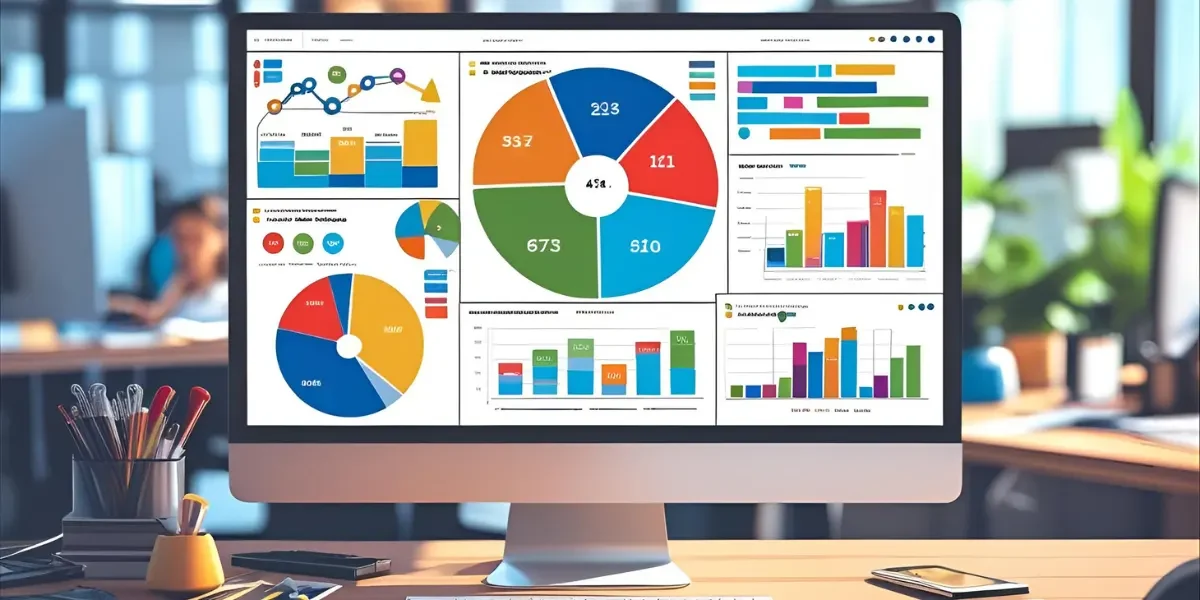
Once your content is optimized, it’s crucial to measure its success. Understanding how your optimized content is performing allows you to make data-driven decisions and refine your SEO strategy. In this section, we’ll discuss key metrics and tools for tracking content optimization success.
Key Metrics: Rankings, CTR, Bounce Rate, Time on Page
To measure the success of your content optimization efforts, focus on the following key performance indicators (KPIs):
- Rankings: Track how well your content is ranking for target keywords. Use tools like Google Search Console or Ahrefs to monitor changes in rankings.
- Click-Through Rate (CTR): The CTR shows how often people click on your content when it appears in search results. A higher CTR indicates that your title tags and meta descriptions are engaging and relevant to searchers.
- Bounce Rate: Bounce rate measures the percentage of visitors who leave your site without interacting with additional pages. A high bounce rate can indicate that your content isn’t engaging or relevant to users.
- Time on Page: This metric shows how long users spend on your page. A longer time on page suggests that your content is engaging and providing value to readers.
- Example: HubSpot (2023) found that their optimized blog posts, with improved CTR and reduced bounce rates, led to a 25% increase in conversions.
Use A/B Testing to Compare Content Versions
A/B testing allows you to test different versions of your content to see which performs better in terms of user engagement and conversions. You can test elements like headlines, CTAs, and images to find the best combination for your audience. By consistently A/B testing, you can refine your content for maximum impact.
- Example: Optimizely (2025) conducted an A/B test on their landing page content and saw a 20% improvement in conversion rates after optimizing their CTAs and headlines.
Content Score Tools and Optimization Benchmarks
There are several content score tools available that analyze your content’s performance and provide insights on how to improve it further. These tools measure factors like keyword density, readability, and semantic relevance, helping you track whether your content is in line with best SEO practices. Tools like Surfer SEO and MarketMuse can help you benchmark your content’s optimization against competitors.
17. Optimizing Content for Voice Search

With the rise of digital assistants like Siri, Google Assistant, and Alexa, voice search has become an increasingly important part of SEO. As more users interact with their devices through voice, it’s essential to optimize your content to cater to voice search queries. In this section, we’ll discuss how to tailor your content for voice search optimization.
Use Natural Language and Conversational Tone
Voice search queries are typically more conversational and natural compared to text-based searches. Users are likely to ask questions like “What are the best SEO practices?” or “How do I improve my website rankings?” To optimize for voice search, ensure your content is written in a natural, conversational tone that answers these types of questions directly.
- Example: Backlinko (2023) optimized their content by using conversational language and answering questions in a way that closely mirrored voice search queries. This resulted in a higher chance of their content appearing in voice search results.
Answer Questions Clearly and Concisely
Google’s featured snippets are often pulled from content that answers a question directly. Voice search queries typically aim to find quick, straightforward answers.
By structuring your content to answer specific questions with concise, easy-to-understand answers, you increase your chances of being selected for voice search results.
- Example: Neil Patel (2023) optimized his blog posts to provide quick answers to commonly asked questions, which helped his content rank for voice search queries.
Focus on Local Queries and Mobile Behavior
Many voice searches are local in nature. For example, users may ask questions like “What’s the nearest coffee shop?” or “Where can I find a plumber near me?” To optimize for these types of queries, ensure your content is optimized for local SEO and includes location-specific information.
Additionally, because most voice searches are conducted on mobile devices, ensure your website is mobile-friendly to accommodate voice search users.
18. Optimization Strategies for Different Content Types
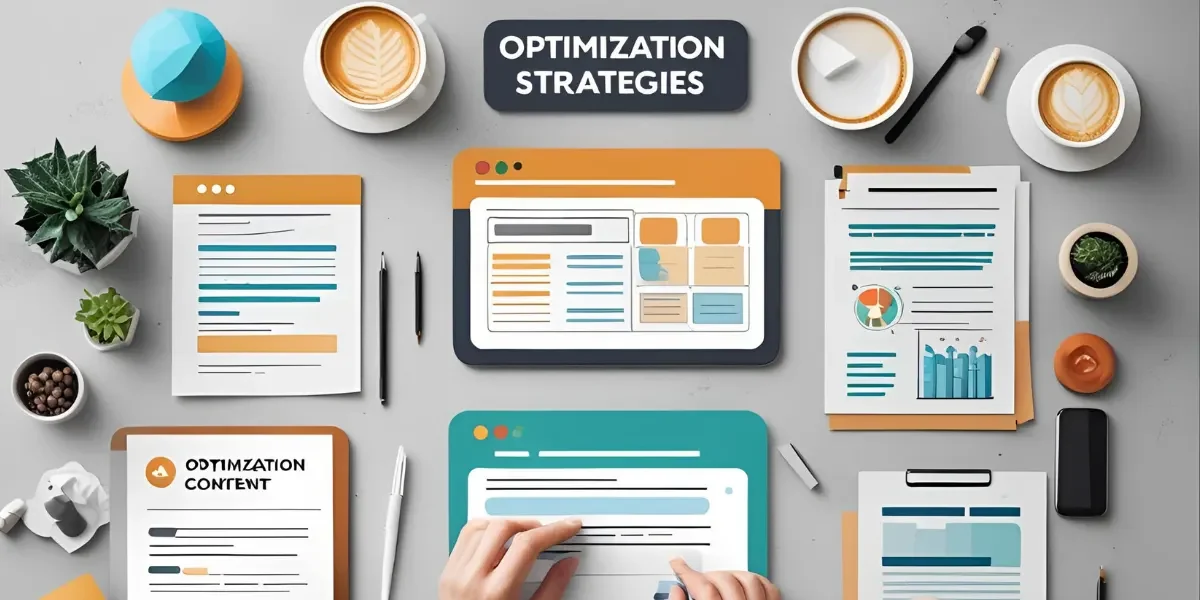
Not all content is created equal, and the strategies for optimizing various types of content differ based on their format and intended purpose. In this section, we will explore how to optimize different content types to enhance SEO performance and user engagement.
Blog Posts: Depth, Authority, and Engagement
Blog posts are often the most common form of content for driving organic traffic. When optimizing blog posts, the key focus should be on depth, authority, and engagement. Make sure your blog posts provide comprehensive coverage of the topic, addressing all relevant aspects of the subject matter. Use authoritative sources and expert opinions to back up your claims. Additionally, engaging visuals and interactive elements like polls or comment sections can increase user interaction.
Product Pages: Features, Benefits, and Schema
For product pages, SEO optimization should focus on showcasing the product’s features, benefits, and customer reviews. Product pages should also use schema markup to provide search engines with structured data about the product, such as price, availability, and reviews. This not only helps search engines understand your product better but also improves your chances of appearing in rich snippets or product carousels in search results.
Landing Pages: Intent Alignment and CTA Focus
Landing pages are designed to drive conversions, so optimization should center around aligning content with user intent and focusing on strong Calls-to-Action (CTAs). Ensure that your landing page addresses the specific pain points of your target audience, includes persuasive content, and features an easy-to-find CTA. Optimization for landing pages often includes A/B testing to test different CTAs, headlines, and layouts to maximize conversions.
Category Pages: SEO Text, Filters, and UX Flow
Category pages serve as a gateway to multiple related products or services, so their optimization should focus on content relevancy, UX flow, and filtering options. SEO text should be included on category pages to provide context and improve rankings. Additionally, ensure the filtering system is user-friendly, as it allows users to quickly find what they’re looking for, which can improve overall user experience and engagement.
19. Advanced Content Optimization Techniques

As SEO continues to evolve, so do the strategies needed to optimize content effectively. In this section, we’ll dive into some advanced content optimization techniques that can give you an edge in the competitive world of digital marketing.
Using NLP Tools to Match Google’s Understanding
Natural Language Processing (NLP) is a branch of AI that allows search engines like Google to understand the context and meaning behind words. By using NLP tools such as Clearscope, Frase, and MarketMuse, you can optimize your content to better align with Google’s understanding of a topic. These tools analyze top-ranking content and suggest related terms, synonyms, and related topics, making sure your content is comprehensive and semantically relevant.
MarketMuse (2025) used NLP tools to enhance the relevance and depth of their blog posts, improving rankings for competitive keywords and increasing organic traffic.
Creating Content Hubs and Topical Clusters
Content hubs and topical clusters are a method of organizing content that makes it easier for search engines to understand the breadth of a subject on your site. By grouping related blog posts into clusters, and linking them back to a central hub page (pillar content), you signal to Google that your site is a trusted resource on that topic. This strategy not only improves SEO but also enhances the user experience by guiding visitors to related content.
Implementing AIO (AI-Optimized) Content Workflows
AI-driven content creation tools like Jasper, Copy.ai, and Surfer SEO now play an integral role in streamlining content creation and optimization. These tools leverage AI to analyze top-ranking pages, identify content gaps, and automatically optimize content for SEO. Implementing AI-optimized workflows can save time, enhance content quality, and improve overall SEO performance.
20. Common Content Optimization Mistakes to Avoid
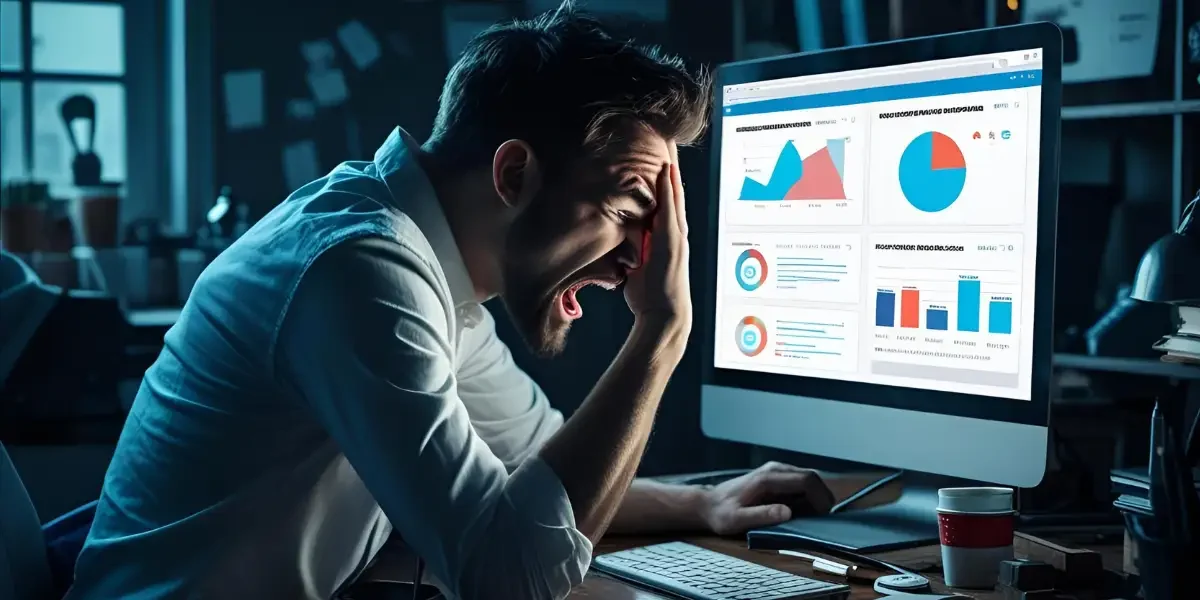
While optimizing content, it’s easy to make mistakes that can hurt your rankings, user experience, and conversions. In this section, we’ll go over some of the most common content optimization mistakes and provide tips on how to avoid them.
Overusing Keywords (Keyword Stuffing)
Keyword stuffing refers to the practice of overloading a piece of content with target keywords in an unnatural way. While it might seem like a good strategy for improving SEO, Google’s algorithms are smart enough to detect keyword stuffing, and it can lead to penalties or decreased rankings. Instead, focus on keyword relevance and semantic SEO by using variations of your target keywords and related terms. Understanding the different types of SEO strategies for better rankings can also help you distribute your optimization efforts more effectively and avoid overusing keywords in a single area.
Ignoring Search Intent or UX Signals
Focusing solely on keywords without considering the search intent behind those keywords can hurt your content’s performance. Search engines now prioritize matching content to the user’s intent, whether it’s informational, navigational, transactional, or commercial. Additionally, ignoring user experience (UX) signals like site speed, mobile-friendliness, and easy navigation can result in high bounce rates and lower rankings. To stay competitive, it’s essential to improve your SEO skills for better optimization results and continuously adapt to evolving industry standards that align with user behavior.
Forgetting to Optimize Metadata or Media
Many websites fail to optimize metadata (title tags, meta descriptions) and media (images, videos) for SEO. Metadata is critical for click-through rates (CTR), and images and videos help boost engagement. Failing to add alt text to images or descriptive file names can result in missed SEO opportunities. Similarly, not optimizing your videos for SEO (e.g., adding proper descriptions and keywords) can prevent them from ranking. This is why it’s vital to understand the importance of SEO in improving organic visibility to build a robust content optimization strategy that drives consistent traffic.
Neglecting to Track Post-Optimization Performance
Once content is optimized, it’s important to regularly monitor its performance. Failing to track key performance metrics like bounce rates, time on page, CTR, and conversions can lead to missed opportunities for further optimization. Use tools like Google Analytics, Google Search Console, and Ahrefs to track post-optimization performance and make adjustments as needed.
Making Optimization Part of Your Ongoing SEO Strategy
Optimizing content should be a continuous process, not a one-time task. Regularly revisit your content to identify areas for improvement, adjust based on performance metrics, and stay up-to-date with SEO best practices. By making content optimization an integral part of your SEO strategy, you can ensure that your content consistently ranks well, engages users, and drives conversions.
Conclusion
Content optimization is the cornerstone of a successful SEO strategy. By continually refining your content to meet SEO best practices, enhancing readability, and providing valuable user experiences, you can improve your rankings, increase engagement, and drive higher conversions. Remember, optimizing content is not a one-time task, but an ongoing process that must evolve alongside changing search engine algorithms and user needs.
With consistent effort and the right strategies, you’ll be better equipped to meet your SEO goals and see tangible results for your business.
If you’re looking to optimize your content or need a customized SEO strategy, FlexForce Pro is here to help. Don’t hesitate to contact us, and let our team assist you in elevating your content and SEO efforts to achieve long-term success.
FAQs
What is content optimization?
Improving the web content so that it can be engaging, relevant, and more visible to the users and the search engines is the process of content optimization, which further improves the experience of the users and the SEO performance.
How do you know your content is optimized for SEO?
The content is optimized properly if it performs well in searches, contains the relevant keywords, loads in a reasonable time, has a good structure which includes; head titles and meta tags, receives backlinks and earns engagement.
How to optimize a website content?
Using relevant keywords, writing valuable content, adding internal links, optimizing meta titles and descriptions, and using H1-H3 headings is a good start. Improving the websites compressing images and making it mobile friendly will further add to its value.
How is SEO optimization done?
Researching a relevant keyword, making on the page improvements, and adding backlinks are the things that can define SEO optimization. Everything mentioned alongs with the usage of Google Analytics and Search Console can provide valuable insights.
How to check SEO ranking?
Using Google Search Console, SEMrush, Ahrefs, and Ubersuggest can not only track the keyword positions, but also track the traffic and visibility trends for the targeted pages and terms.
